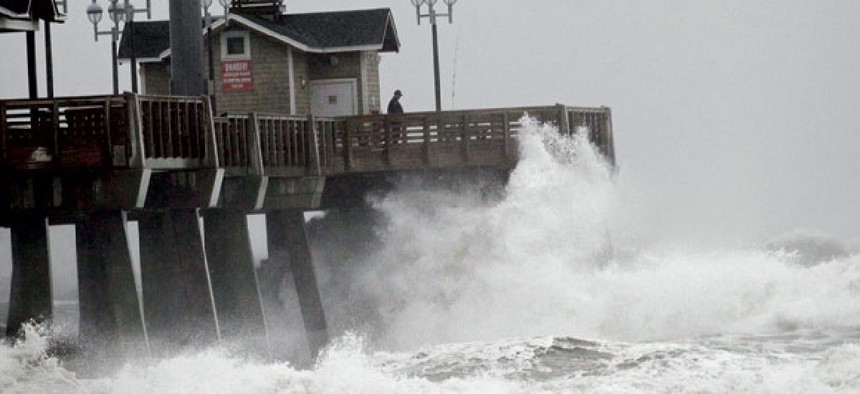
Gerry Broome/AP
Storm Surge
FEMA’s fledgling business liaison office sets corporate resources in motion during emergencies.
As Superstorm Sandy approached landfall on Oct. 29, 2012, a small, freshly minted office at the Federal Emergency Management Agency got ready.
The National Business Emergency Operations Center, launched only two months earlier, organized a conference call with 330 representatives from the public and private sectors to talk strategy. Participants included retail, transportation, food and building management experts. The day before, first responders in North Carolina already were working with FEMA to round up critical resources.
At 1 a.m., officials told Enterprise Rent-A-Car about a need for vehicles, which the company had ready at airports before federal offices opened at 5:30 a.m.
The business operations center, a virtual two-way information channel between the public and private sectors, bolsters the FEMA principle that “it doesn’t cost money to share information,” says Dan Stoneking, the director of the agency’s private sector division who recently became a regional external affairs officer. “We say here’s how government resources are being moved and they share their needs and capabilities. They tell us what’s happening in their own area, what stores and restaurants are open or closed.”
The office of just five staffers with a minuscule budget is augmented by corporate representatives who rotate in on 90-day stints. During its maiden voyage in August, when the milder Hurricane Isaac hit the Gulf Coast, the information clearinghouse was a hit. Businesses “signed up so fast it was hard to keep track,” Stoneking says.
The way it works is liaisons from retail businesses, such as Waffle House and Walgreens, provide updates on which of their locations are open during a storm, allowing FEMA to “picture the path of the disaster over several days,” Stoneking says. That helps FEMA coordinate supplies such as electricity generators and “allows both [the public and private sector] . . . . to determine, with state and local offices, where to set up disaster recovery centers and choose point-of-distribution locations,” he adds.
“One discovery we made was that local energy company managers love to know who’s open to provide customers with a place to charge devices—not just cellphones but life-saving medical devices,” Stoneking says. “If a store opens, we can use social media to tell people whether they can use it to charge up. Everyone wins—the store gets more customers,
the customers get charged, and the emergency medical technicians don’t have to go to a private home to save a patient.”
The center’s launch was welcomed by the private sector, too. “It’s mutual assistance,” says Rodney Blevins, vice president of distribution operations for Dominion Virginia Power. “This allows us to make sure FEMA understands how the utilities go about the process of supporting each other during a crisis. And conversely, we get a better understanding of how FEMA responds. If we’re in the same place, we will be more effective.”
The direct line to FEMA also improves existing services to federal agencies. Enterprise, for example, “has a standing relationship with the General Services Administration, with contracts and a standing agreement on rates before disaster strikes,” says Bryan Scott, director of federal government sales at Enterprise Holdings.
GSA’s centralized Rental Supplemental Vehicles Program has prompted Enterprise to centralize its federal government support team. “It’s a central desk for all things federal government in times of disaster,” Scott says. But a national emergency also can open up program opportunities at the state and local levels, where the company’s operating units in 7,000 locations can step in.
Do private companies profit from participating in disaster relief? “We’re not just a business, but part of the communities, and social services is a big part of that,” says Greg Stubblefield, chief strategy officer and executive vice president of global sales, marketing and strategy for Enterprise Holdings. “Our folks live and work in those areas, so in times of natural disaster, we need to make friends and not profits.”
FEMA’s new center, Stoneking adds, “is open to everyone, so there are no problems among competitors. We get Starbucks, Waffle House, Target, Citibank, Verizon. No one is worried about competition when they’re in a crisis mode. ”
NEXT STORY: Around Government







